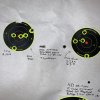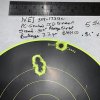Joshua
Taco Aficionado/Salish Sea Pirate/Part-Time Dragon
While lubed bullets may do well when sized to the throat diameter, the lube smears and flows to where it needs to be. PC is however like a very thin plastic jacket that you don’t want to cut or tear, therefore a smidge over groove diameter seems to be the sizing recommendation.
I’m still in the early experimentation phase with PC, but this is my general understanding of it’s mechanics.
Josh
I’m still in the early experimentation phase with PC, but this is my general understanding of it’s mechanics.
Josh
Last edited:




